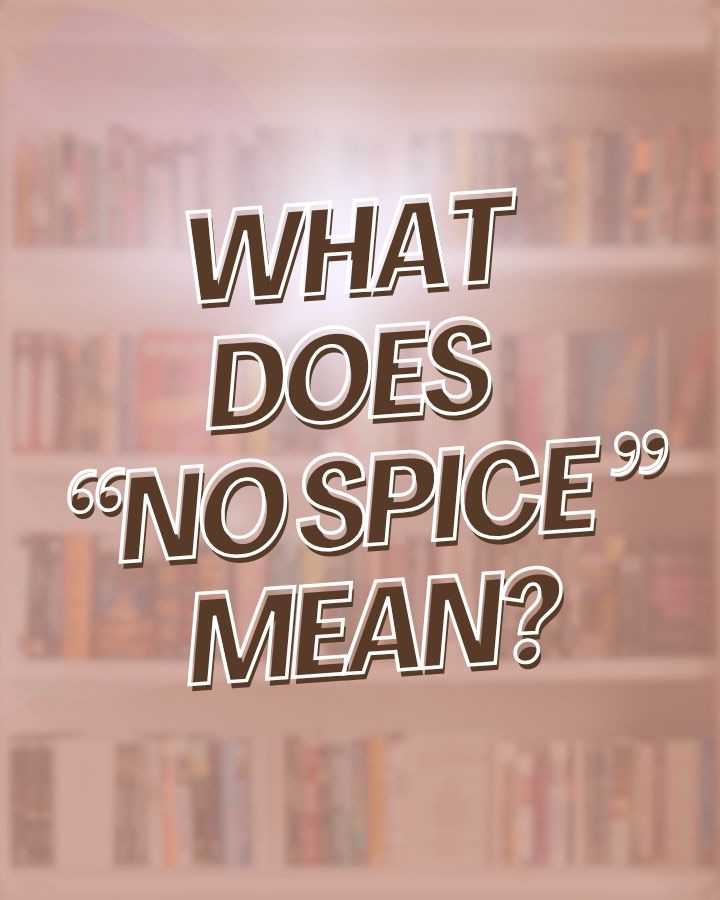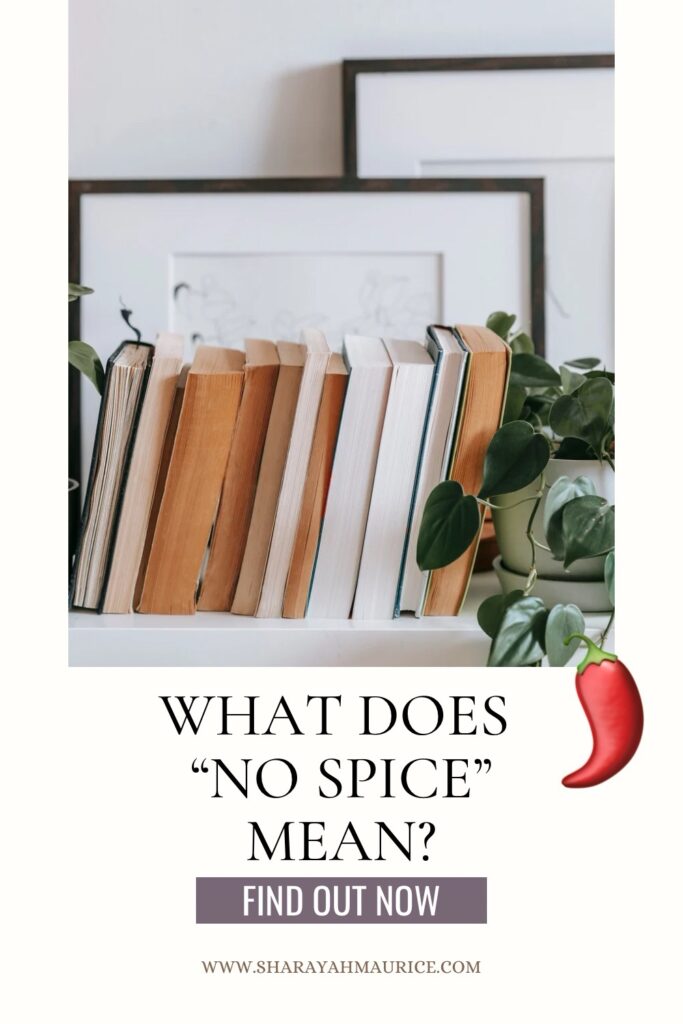Curious what “no spice” means in books? Let’s break down what readers and authors mean when they talk about “spice” and what that looks like here on my blog.

What “No/Low Spice” Means in My Book Lists
When I say a book is no spice or low spice, I mean stories that focus on emotional connection, tension, and romance without explicit sexual content.
💬 No spice: No sexual scenes at all (may include light kissing or fade-to-black moments).
💬 Low spice: Brief or implied intimate acts, but never described explicitly.
Every book I share will always fall within those boundaries. You’ll never find explicit, open-door content here.
If you’re new to the term and want to understand how readers use “spice” to describe intimacy in books, keep reading below.
What is a “spicy” book?
When readers call a book spicy, they’re referring to sexual content that’s shown or described on the page. These are also known as “open-door” books.
If a story includes multiple detailed scenes, readers often call it smut, and those titles tend to fit better in the erotica genre—where the romance and sexual elements drive the story as much (or more) than the plot.
Spice in Young Adult Books
Unfortunately, open-door content has become increasingly common in books marketed to young adults. As a mom of teens, I believe explicit scenes don’t belong in YA, which traditionally targets ages 13–18.
While many adults read YA too, I personally don’t want my thirteen-year-old reading graphic sexual descriptions. Because of that, many authors now clearly identify whether their books contain “spice” and more are embracing no-spice storytelling.
Understanding Spice Levels
“Spice” exists on a spectrum. Some readers want no romance at all, while others are comfortable with light kissing or fade-to-black moments (where intimacy is implied but never described).
Since definitions vary, readers and authors have developed informal systems to describe spice levels and help each other find the right fit.
The Chili Pepper System
The most popular shorthand is the chili pepper system, where reviewers use peppers to show how much spice a book contains:
🫑 Green pepper: No spice
🌶️ One chili pepper: Light or low spice
🌶️🌶️🌶️ Three+ chili peppers: Open-door, explicit content
It’s not universal—every reader interprets it differently—but it’s a quick way to gauge what to expect.
How to Screen Books for Spice (and Other Content)
If you’re unsure whether a book is spicy, here are a few easy ways to check:
- Read the description. Many authors now include a note about spice or content at the bottom of their blurb.
- Check reviews. Search for keywords like “spice,” “clean,” or “closed door” on Goodreads or Amazon. Look for green peppers or low-pepper ratings.
- Search inside the book. On Kindle, you can search for specific words or phrases before deciding to read or buy. Same with digital books borrowed from the library.
- Ask the community. Bookstagram and BookTok creators often mention spice levels in reviews or create dedicated clean-read lists. The Real Life Book Reviewer has a clearly defined chili pepper system, and includes what specific chapters to skip if you still want to read the book but avoid the spice.
- Ask AI. You can ask any AI platform, (ChatGPT, Gemini, etc) though the results might vary depending on the sources AI scans.
No-Spice Book Library
If you don’t want to go through the trouble of screening books yourself, I’ve done it for you! My Clean Fantasy Romance Library is a curated collection of magical, no-spice reads. Every title has been carefully reviewed using the method listed above to ensure it fits the clean, no-spice standard.
Whether you’re looking for epic fantasy adventures, cozy romances, or enchanting series to binge, this library makes it easy to find your next read without worrying about hidden spice. Browse the library and discover your next favorite clean fantasy romance today!
A Note on My Book Lists
Because “no spice” and “low spice” can mean slightly different things to different readers, I include both in my recommendations.
You’ll never find explicit on-page sexual content here. My lists range from completely no-spice stories to light, cracked-door romances that focus on emotional depth, tension, and slow-burn connection.
Using “low spice” simply acknowledges that gray area between definitions and helps you know exactly what to expect when browsing my lists. When possible, I will define a book as ‘low spice’ if it reaches into that gray area.
Final Thoughts
In short:
- “Spice” = sexual content on-page
- “No spice” = none of that content present
- “Low spice” = mild or implied intimacy, never explicit
Reading no-spice or clean fantasy romance doesn’t mean you’re missing out on adventure, emotion, or magical worlds — it just means you get to enjoy the story without the worry of adult content. Whether you’re picking a book for yourself, a younger reader, or just want a cozy, safe escape, understanding what “no spice” means and knowing how to find these titles makes reading even more enjoyable.
Pin It


Leave a Reply